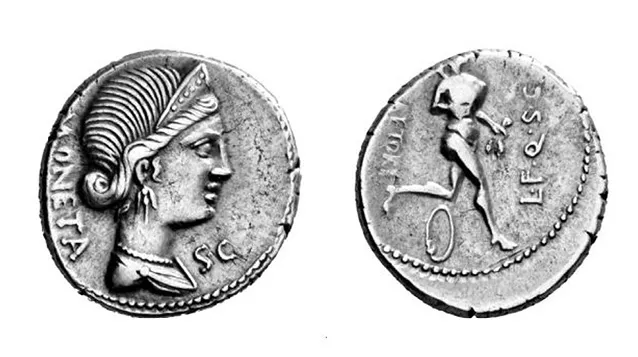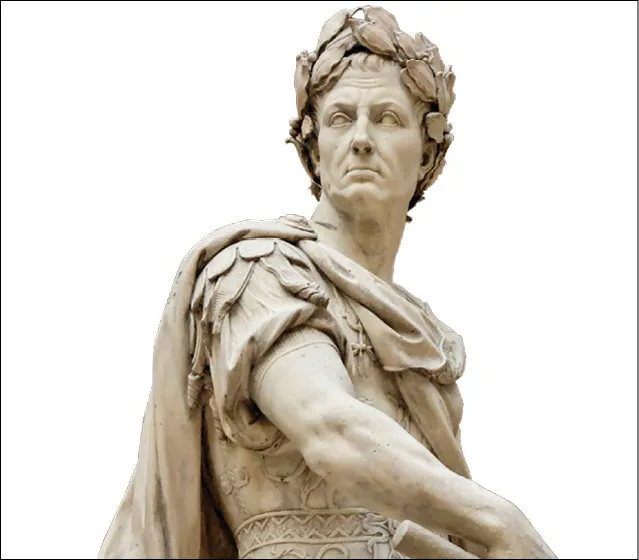![]()
Chapter I
How Usury Destroyed the Roman Empire
Money, being naturally barren, to make it breed money is preposterous and a perversion from the end of its institution, which was only to serve the purpose of exchange and not of increase...Men called bankers we shall hate, for they enrich themselves while doing nothing.
– Aristotle, Politics
The monetary systems of the Roman era (753BC – 565AD) may be divided into three distinct periods, where units of three different metals were used as the means of exchanging goods and services.Although there is evidence of modern human occupation (Homo sapiens sapiens) in the Rome area going back 14,000 years (with Neanderthals having lived there approximately 140,000 years ago), Rome, as a city, is traditionally said to have been founded by Romulus and Remus in 753BC in a region surrounding the Palatine Hills, also known as Latium. According to the legend, Romulus (who killed his brother Remus) became its first king, but later shared the throne with Titus Tatius, the ruler of the Sabines.
Around 600BC Latium came under the control of the Etruscans. This lasted until the last king, Tarquin the Proud, was expelled in 509BC and the Roman Republic was established. The Etruscans, a people of Aryan origin, created one of the most advanced civilisations of that period and built roads, temples and numerous public buildings in Rome.
The first “money” used in Rome was the cow. This was not true money, but a barter system. Many early peoples used cattle as a medium of exchange. According to the legend of Herakles and the Augean stables, the cattle kept there, over 3,000 in number, represented the treasury of King Augeas.
THE COPPER AGE (753 – 267BC)
As time went on, the Romans took to using, instead of cattle, irregular lumps of copper or bronze. These lumps were called aes rude (rough metal) and had to be weighed for each transaction.
There was an increase in trade and Rome became one of the most prosperous cities in the ancient world. This prosperity was based on uncoined copper, later bronze, metal which was measured by weight according to a fixed system of units. It was issued by the Roman Treasury in the form of ingots weighing 3½ lbs (1.6kg) with the full backing of the state and was known as aes signatum (stamped metal), because it was stamped by the government with a cow, eagle or elephant or other image. Sometimes they were made to resemble a scallop shell. In 289BC these ingots were replaced by discoidal, cast leaded bronze coins aes grave (heavy metal). They represented national money and “were paid into circulation by the state and only of value inasmuch as the symbols on which its numbers were recorded, were scarce or otherwise.”1 This money was thus based on law rather than the metallic content (although that content was standardised, and the coin did have some intrinsic value, unlike most coins today). This can be considered as an early example of the successful use of fiat money.
While fiat money is much criticised in some quarters, for example by the followers of Austrian economist Ludwig von Mises,2 there is nothing wrong with it, as long as it is issued by government, not by private bankers, and is carefully protected against counterfeiters. Non-fiat money, in contrast, has the serious drawback that whoever sets the prices of gold and silver, i.e. private bankers, can control the nation’s economy.
Roman Aes Grave, bronze coins 241-235 BC.Up to 300BC there was an unsurpassed increase in public and private wealth of the Romans. This may be measured in the gain in land. After the conclusion of the Second Latin War in 338BC and the defeat of the Etruscans, the Roman Republic increased in size from 2,135 square miles (5,525 sq km) to 10,350 square miles (26,805 sq km) or 20% of peninsular Italy. In tandem with the expansion of its land area the population rose from about 750,000 to one million with 150,000 persons living in Rome itself.
A partnership was formed between the Senate and the people known as Senatus Populusque Romanus (SPQR, the Senate and People of Rome). The political leaders were renowned for their frugality and honest virtue. The means of exchange was strictly regulated in accordance with the increase in population and trade and there was zero inflation. Debt-bondage nexum, whereby a free man offered his services as security for a loan + interest, and where in cases of non-payment the debt had to be worked off, was abolished after Plebian agitation by the lex Poetelia 3 in 326BC.
THE SILVER AGE (267 – 27BC)
The traditional money system was destroyed in 267BC when the patrician elite obtained the privilege to mint silver coinage. This change was typified by a patrician who went to the Temple of Juno Moneta (from whence the word money is derived), and converted a sack full of silver denarii to five times its original value by the simple expedient of stamping a new value on the coins. He thus pocketed a very substantial difference in seigniorage for his own private account.
The early Roman silver coin was known as the drachma and was modelled on a coin used in the Greek south of the peninsula. It was later replaced with the smaller and lighter denarius. There was also a half denarius, called the quinarius and a quarter unit called the sestertius. Still later the system was supplemented with the victoriatus, somewhat lighter than the denarius and probably intended to facilitate trade with Rome’s Greek neighbours.
There were very few deposits of silver in the Italian peninsula and as a consequence the Roman army had to be expanded, in order to conquer territories to obtain supplies. The Roman peasants, who had provided the Republic with food independence, were drafted in increasing numbers into the army. Agricultural production, especially corn, declined and the peasant farms were replaced by latifundia, which were large estates worked by slaves. Wheat also had to be imported from North Africa.
Tensions about granting citizenship and enfranchisement between Rome and her Italic allies resulted in the Social War (90-89BC). This lack of enfranchisement had led to the fragmentation of Roman society and the alienation of the working class citizens, who were treated as chattel and who had no responsibilities and therefore no commitment towards the state. Until as late as the Second Punic War (218-201BC), they were not allowed to serve in the army. This is a classic example of a society which had been monetarised. The Republic was weakened and there was increasing despotism. Piracy became a major problem, with raids taking place on the coast, villas being sacked and travellers kidnapped. Violence became endemic and gangsters and terrorists were active in Rome, as there was no police force to maintain law and order. These are inevitable consequences of a society in which money has become the highest ethos.
There was political intrigue amongst the elite, and economic deprivation amongst the poor, and with large population of slaves from North Africa, it all contributed to the social unrest. This turmoil culminated in the revolt led by Spartacus in 73-71BC. (The first and second revolts were in 135-132BC and in 104-100BC).
Roman Republican silver Denarius
with (left) goddess Juno Moneta and (right) a victorious boxer.JULIUS CAESAR
Julius Caesar (100-44BC) was born into an aristocratic family on July 12, 100BC. He was tall and fair-headed and practised briefly as a lawyer before becoming a brilliant military commander who conquered Gaul (France) in 59-52BC. After his defeat of Pompey the Great in 48BC at Pharsalus, Caesar became the undisputed leader of the Roman Republic. On his return to Italy in September 45BC, Caesar found the streets and cities crowded with homeless people, who had been forced off the land by usurers and land monopolists. 300,000 people had to be fed daily at the public granary. Usury was flourishing with disastrous consequences.4
Statue of Julius Caesar. Commissioned in 1696 for the Gardens of Versailles.The principal usurers, were charging interest rates as high as 48% per annum. As Lucius Annaeus Seneca (4BC-65AD), the philosopher, would later remark in de Superstitione “The customs of that most criminal nation have gained such strength that they have now been received in all lands. The conquered have given laws to the conqueror.”
At that time there were two main political parties: the Optimates centered around the nobility, the Senate and the privileged few; and the Populares, who represented the citizens. Caesar immediately assumed leadership of the latter.
Caesar fully understood the evils of usury and how to counter them. “He recognized the profound truth that money is a national agent, created by law for a national purpose, and that no classes of men should withhold it from circulation so as to cause panics, in order that speculators could advance the rates of interest, or could buy up property at ruinous prices after such panic.”
Caesar introduced the following social reforms:
Restoration of property was done at the much lower valuations which held prior to the civil war. (49-45BC).
Several remissions of rents were granted.
Large numbers of poor citizens and discharged veterans were settled on allotments.
Free housing was provided to 80,000 impoverished families.
Soldiers’ pay was increased from 123 to 225 denarii.
The cor...



